technical specifications Alfa Romeo Brera/Spider 2008 Owner handbook (in English)
[x] Cancel search | Manufacturer: ALFA ROMEO, Model Year: 2008, Model line: Brera/Spider, Model: Alfa Romeo Brera/Spider 2008Pages: 270, PDF Size: 3.93 MB
Page 96 of 270
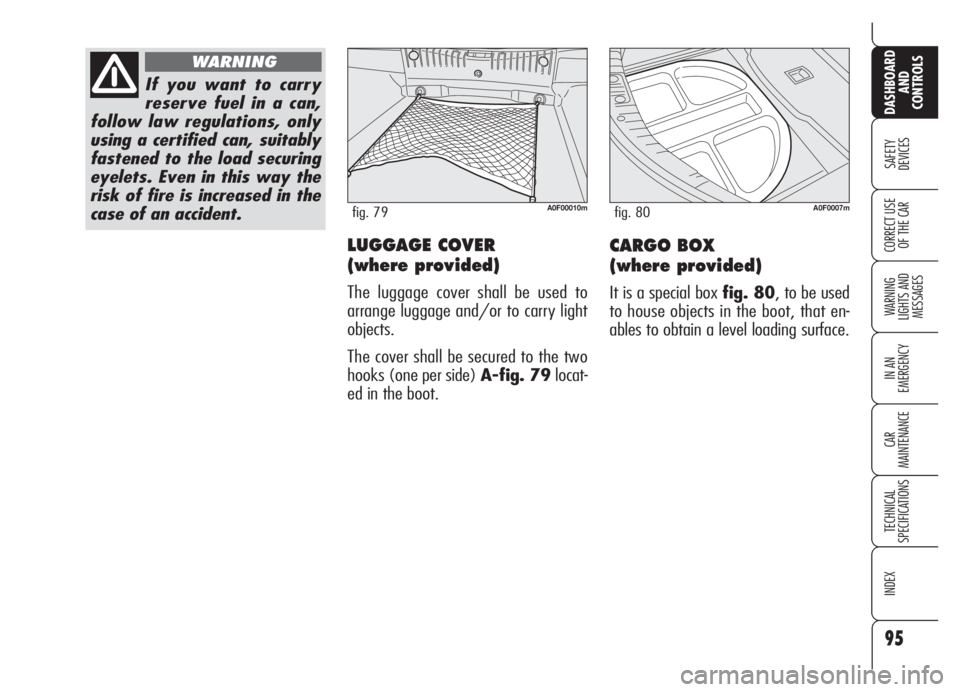
95
SAFETY
DEVICES
WARNING
LIGHTS AND
MESSAGES
IN AN
EMERGENCY
CAR
MAINTENANCE
TECHNICAL
SPECIFICATIONS
INDEX
DASHBOARD
AND
CONTROLS
CORRECT USE
OF THE CAR
If you want to carry
reserve fuel in a can,
follow law regulations, only
using a certified can, suitably
fastened to the load securing
eyelets. Even in this way the
risk of fire is increased in the
case of an accident.
WARNING
LUGGAGE COVER
(where provided)
The luggage cover shall be used to
arrange luggage and/or to carry light
objects.
The cover shall be secured to the two
hooks (one per side) A-fig. 79locat-
ed in the boot.
A0F00010mfig. 79
CARGO BOX
(where provided)
It is a special box fig. 80, to be used
to house objects in the boot, that en-
ables to obtain a level loading surface.
A0F0007mfig. 80
Page 97 of 270
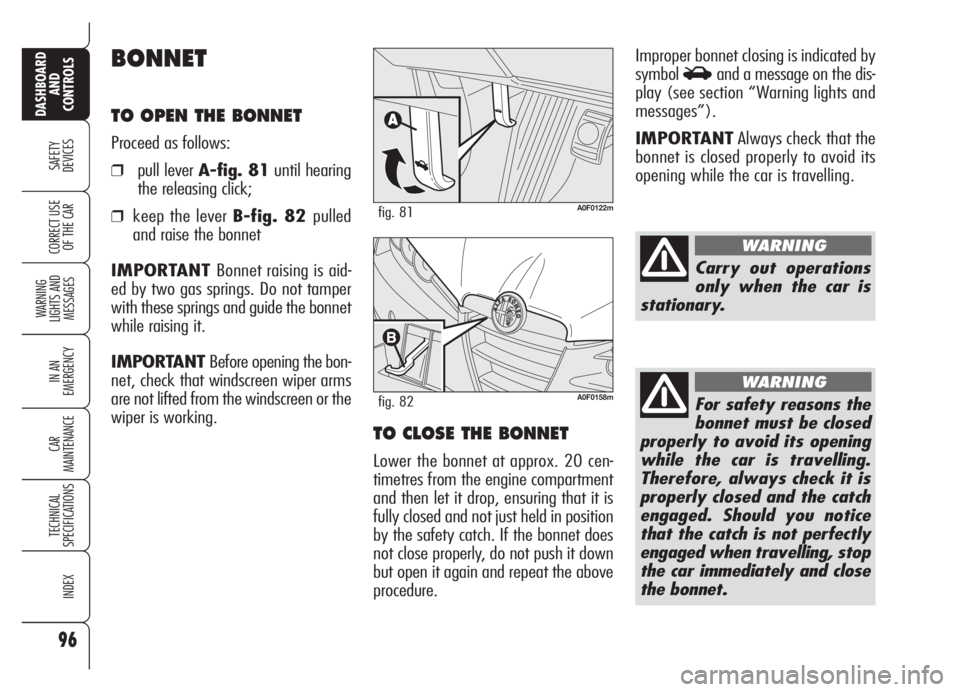
96
SAFETY
DEVICES
WARNING
LIGHTS AND
MESSAGES
IN AN
EMERGENCY
CAR
MAINTENANCE
TECHNICAL
SPECIFICATIONS
INDEX
DASHBOARD
AND
CONTROLS
CORRECT USE
OF THE CAR
BONNET
TO OPEN THE BONNET
Proceed as follows:
❒pull lever A-fig. 81until hearing
the releasing click;
❒keep the lever B-fig. 82 pulled
and raise the bonnet
IMPORTANT Bonnet raising is aid-
ed by two gas springs. Do not tamper
with these springs and guide the bonnet
while raising it.
IMPORTANT Before opening the bon-
net, check that windscreen wiper arms
are not lifted from the windscreen or the
wiper is working.A0F0122mfig. 81
A0F0158mfig. 82
Improper bonnet closing is indicated by
symbol
Sand a message on the dis-
play (see section “Warning lights and
messages”).
IMPORTANTAlways check that the
bonnet is closed properly to avoid its
opening while the car is travelling.
Carry out operations
only when the car is
stationary.
WARNING
For safety reasons the
bonnet must be closed
properly to avoid its opening
while the car is travelling.
Therefore, always check it is
properly closed and the catch
engaged. Should you notice
that the catch is not perfectly
engaged when travelling, stop
the car immediately and close
the bonnet.
WARNING
TO CLOSE THE BONNET
Lower the bonnet at approx. 20 cen-
timetres from the engine compartment
and then let it drop, ensuring that it is
fully closed and not just held in position
by the safety catch. If the bonnet does
not close properly, do not push it down
but open it again and repeat the above
procedure.
Page 98 of 270
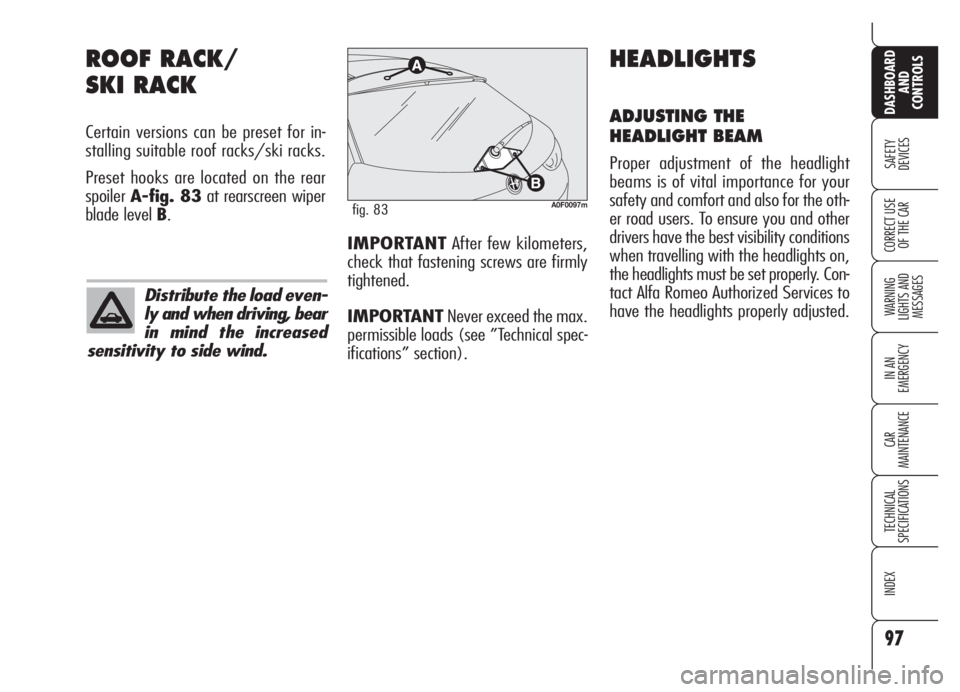
97
SAFETY
DEVICES
WARNING
LIGHTS AND
MESSAGES
IN AN
EMERGENCY
CAR
MAINTENANCE
TECHNICAL
SPECIFICATIONS
INDEX
DASHBOARD
AND
CONTROLS
CORRECT USE
OF THE CAR
ROOF RACK/
SKI RACK
Certain versions can be preset for in-
stalling suitable roof racks/ski racks.
Preset hooks are located on the rear
spoilerA-fig. 83at rearscreen wiper
blade level B.
A0F0097mfig. 83
HEADLIGHTS
ADJUSTING THE
HEADLIGHT BEAM
Proper adjustment of the headlight
beams is of vital importance for your
safety and comfort and also for the oth-
er road users. To ensure you and other
drivers have the best visibility conditions
when travelling with the headlights on,
the headlights must be set properly. Con-
tact Alfa Romeo Authorized Services to
have the headlights properly adjusted.
Distribute the load even-
ly and when driving, bear
in mind the increased
sensitivity to side wind.
IMPORTANTAfter few kilometers,
check that fastening screws are firmly
tightened.
IMPORTANTNever exceed the max.
permissible loads (see ”Technical spec-
ifications” section).
Page 99 of 270
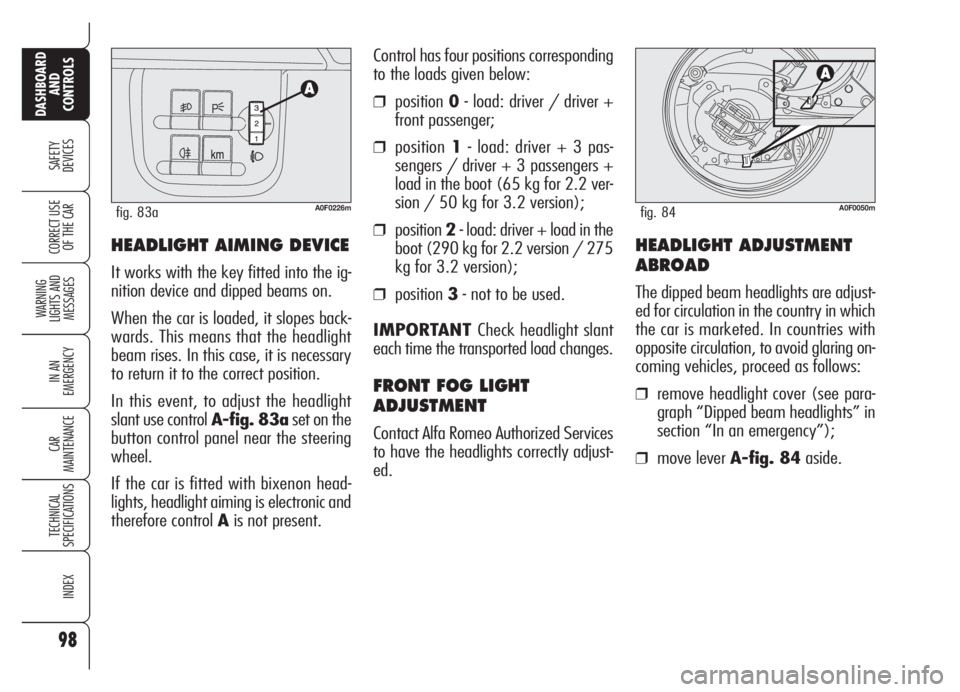
98
SAFETY
DEVICES
WARNING
LIGHTS AND
MESSAGES
IN AN
EMERGENCY
CAR
MAINTENANCE
TECHNICAL
SPECIFICATIONS
INDEX
DASHBOARD
AND
CONTROLS
CORRECT USE
OF THE CARHEADLIGHT AIMING DEVICE
It works with the key fitted into the ig-
nition device and dipped beams on.
When the car is loaded, it slopes back-
wards. This means that the headlight
beam rises. In this case, it is necessary
to return it to the correct position.
In this event, to adjust the headlight
slant use control A-fig. 83aset on the
button control panel near the steering
wheel.
If the car is fitted with bixenon head-
lights, headlight aiming is electronic and
therefore control Ais not present.Control has four positions corresponding
to the loads given below:
❒position0- load: driver / driver +
front passenger;
❒position1- load: driver + 3 pas-
sengers / driver + 3 passengers +
load in the boot (65 kg for 2.2 ver-
sion / 50 kg for 3.2 version);
❒position2- load: driver + load in the
boot (290 kg for 2.2 version / 275
kg for 3.2 version);
❒position3- not to be used.
IMPORTANT Check headlight slant
each time the transported load changes.
FRONT FOG LIGHT
ADJUSTMENT
Contact Alfa Romeo Authorized Services
to have the headlights correctly adjust-
ed.
A0F0226mfig. 83a
HEADLIGHT ADJUSTMENT
ABROAD
The dipped beam headlights are adjust-
ed for circulation in the country in which
the car is marketed. In countries with
opposite circulation, to avoid glaring on-
coming vehicles, proceed as follows:
❒remove headlight cover (see para-
graph “Dipped beam headlights” in
section “In an emergency”);
❒move lever A-fig. 84aside.
A0F0050mfig. 84
Page 100 of 270
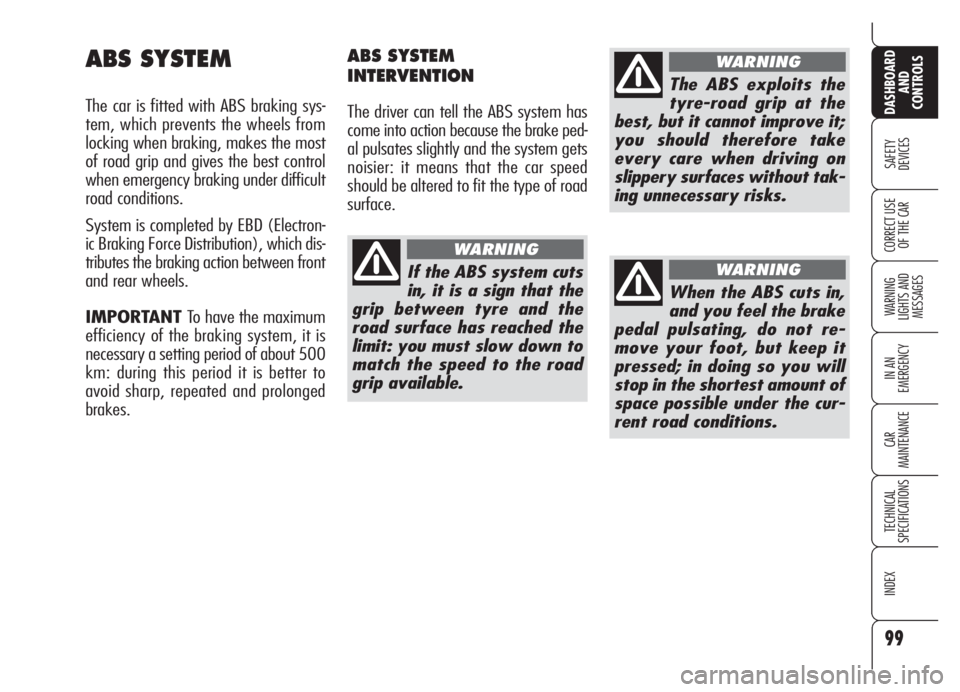
99
SAFETY
DEVICES
WARNING
LIGHTS AND
MESSAGES
IN AN
EMERGENCY
CAR
MAINTENANCE
TECHNICAL
SPECIFICATIONS
INDEX
DASHBOARD
AND
CONTROLS
CORRECT USE
OF THE CAR
ABS SYSTEM
The car is fitted with ABS braking sys-
tem, which prevents the wheels from
locking when braking, makes the most
of road grip and gives the best control
when emergency braking under difficult
road conditions.
System is completed by EBD (Electron-
ic Braking Force Distribution), which dis-
tributes the braking action between front
and rear wheels.
IMPORTANT To have the maximum
efficiency of the braking system, it is
necessary a setting period of about 500
km: during this period it is better to
avoid sharp, repeated and prolonged
brakes.
ABS SYSTEM
INTERVENTION
The driver can tell the ABS system has
come into action because the brake ped-
al pulsates slightly and the system gets
noisier: it means that the car speed
should be altered to fit the type of road
surface.
If the ABS system cuts
in, it is a sign that the
grip between tyre and the
road surface has reached the
limit: you must slow down to
match the speed to the road
grip available.
WARNING
The ABS exploits the
tyre-road grip at the
best, but it cannot improve it;
you should therefore take
every care when driving on
slippery surfaces without tak-
ing unnecessary risks.
WARNING
When the ABS cuts in,
and you feel the brake
pedal pulsating, do not re-
move your foot, but keep it
pressed; in doing so you will
stop in the shortest amount of
space possible under the cur-
rent road conditions.
WARNING
Page 101 of 270
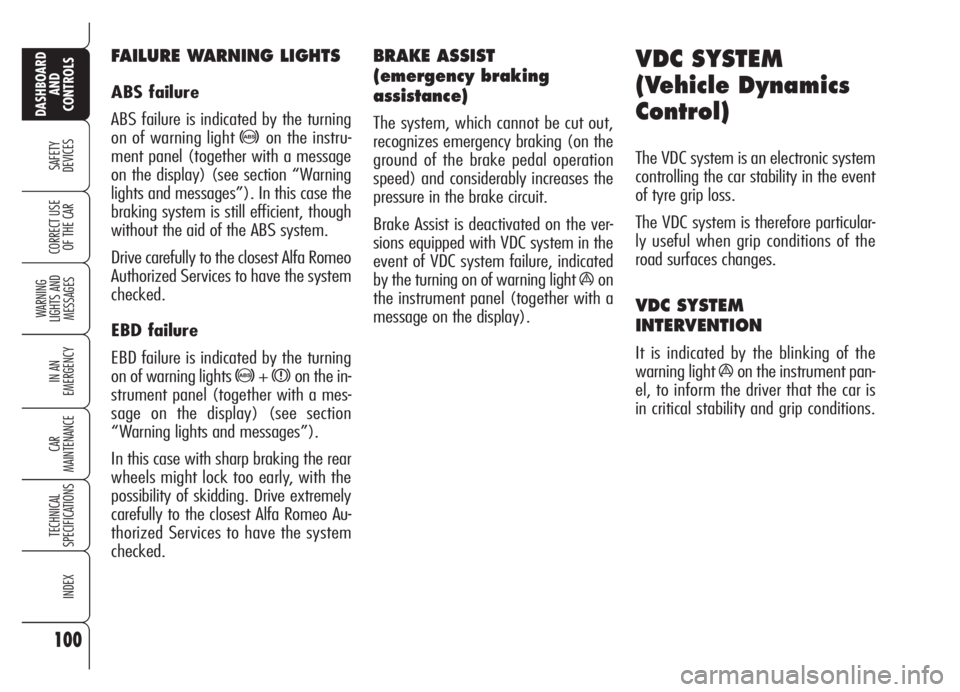
100
SAFETY
DEVICES
WARNING
LIGHTS AND
MESSAGES
IN AN
EMERGENCY
CAR
MAINTENANCE
TECHNICAL
SPECIFICATIONS
INDEX
DASHBOARD
AND
CONTROLS
CORRECT USE
OF THE CAR
BRAKE ASSIST
(emergency braking
assistance)
The system, which cannot be cut out,
recognizes emergency braking (on the
ground of the brake pedal operation
speed) and considerably increases the
pressure in the brake circuit.
Brake Assist is deactivated on the ver-
sions equipped with VDC system in the
event of VDC system failure, indicated
by the turning on of warning light
áon
the instrument panel (together with a
message on the display).
FAILURE WARNING LIGHTS
ABS failure
ABS failure is indicated by the turning
on of warning light
>on the instru-
ment panel (together with a message
on the display) (see section “Warning
lights and messages”). In this case the
braking system is still efficient, though
without the aid of the ABS system.
Drive carefully to the closest Alfa Romeo
Authorized Services to have the system
checked.
EBD failure
EBD failure is indicated by the turning
on of warning lights
>+xon the in-
strument panel (together with a mes-
sage on the display) (see section
“Warning lights and messages”).
In this case with sharp braking the rear
wheels might lock too early, with the
possibility of skidding. Drive extremely
carefully to the closest Alfa Romeo Au-
thorized Services to have the system
checked.
VDC SYSTEM
(Vehicle Dynamics
Control)
The VDC system is an electronic system
controlling the car stability in the event
of tyre grip loss.
The VDC system is therefore particular-
ly useful when grip conditions of the
road surfaces changes.
VDC SYSTEM
INTERVENTION
It is indicated by the blinking of the
warning light
áon the instrument pan-
el, to inform the driver that the car is
in critical stability and grip conditions.
Page 102 of 270
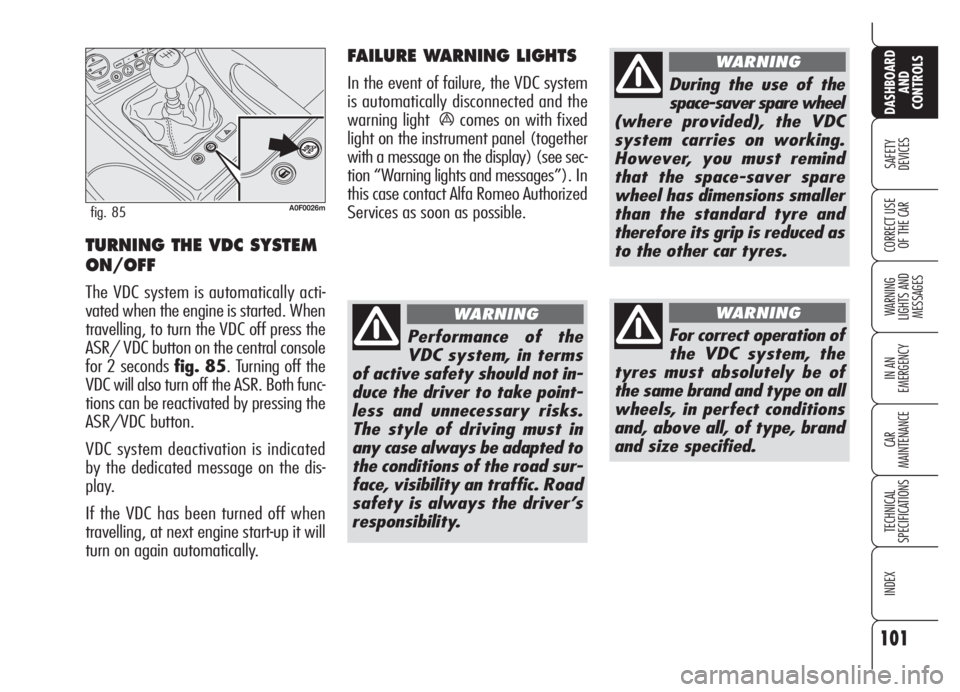
101
SAFETY
DEVICES
WARNING
LIGHTS AND
MESSAGES
IN AN
EMERGENCY
CAR
MAINTENANCE
TECHNICAL
SPECIFICATIONS
INDEX
DASHBOARD
AND
CONTROLS
CORRECT USE
OF THE CARTURNING THE VDC SYSTEM
ON/OFF
The VDC system is automatically acti-
vated when the engine is started. When
travelling, to turn the VDC off press the
ASR/ VDC button on the central console
for 2 seconds fig. 85. Turning off the
VDC will also turn off the ASR. Both func-
tions can be reactivated by pressing the
ASR/VDC button.
VDC system deactivation is indicated
by the dedicated message on the dis-
play.
If the VDC has been turned off when
travelling, at next engine start-up it will
turn on again automatically.
A0F0026mfig. 85
Performance of the
VDC system, in terms
of active safety should not in-
duce the driver to take point-
less and unnecessary risks.
The style of driving must in
any case always be adapted to
the conditions of the road sur-
face, visibility an traffic. Road
safety is always the driver’s
responsibility.
WARNING
During the use of the
space-saver spare wheel
(where provided), the VDC
system carries on working.
However, you must remind
that the space-saver spare
wheel has dimensions smaller
than the standard tyre and
therefore its grip is reduced as
to the other car tyres.
WARNING
For correct operation of
the VDC system, the
tyres must absolutely be of
the same brand and type on all
wheels, in perfect conditions
and, above all, of type, brand
and size specified.
WARNING
FAILURE WARNING LIGHTS
In the event of failure, the VDC system
is automatically disconnected and the
warning light
ácomes on with fixed
light on the instrument panel (together
with a message on the display) (see sec-
tion “Warning lights and messages”). In
this case contact Alfa Romeo Authorized
Services as soon as possible.
Page 103 of 270
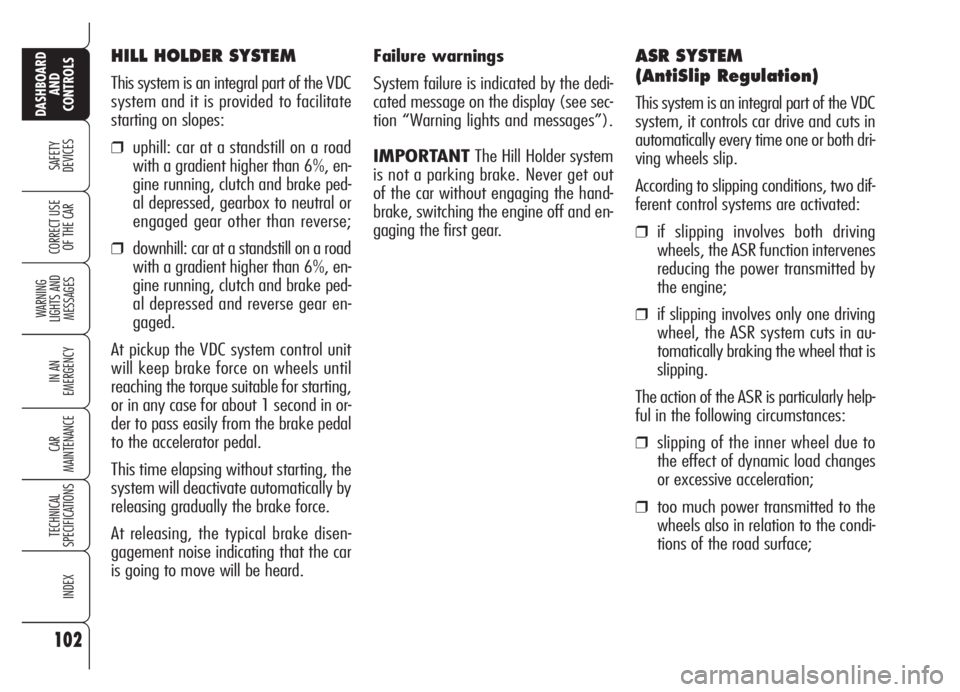
102
SAFETY
DEVICES
WARNING
LIGHTS AND
MESSAGES
IN AN
EMERGENCY
CAR
MAINTENANCE
TECHNICAL
SPECIFICATIONS
INDEX
DASHBOARD
AND
CONTROLS
CORRECT USE
OF THE CAR
HILL HOLDER SYSTEM
This system is an integral part of the VDC
system and it is provided to facilitate
starting on slopes:
❒uphill: car at a standstill on a road
with a gradient higher than 6%, en-
gine running, clutch and brake ped-
al depressed, gearbox to neutral or
engaged gear other than reverse;
❒downhill: car at a standstill on a road
with a gradient higher than 6%, en-
gine running, clutch and brake ped-
al depressed and reverse gear en-
gaged.
At pickup the VDC system control unit
will keep brake force on wheels until
reaching the torque suitable for starting,
or in any case for about 1 second in or-
der to pass easily from the brake pedal
to the accelerator pedal.
This time elapsing without starting, the
system will deactivate automatically by
releasing gradually the brake force.
At releasing, the typical brake disen-
gagement noise indicating that the car
is going to move will be heard.Failure warnings
System failure is indicated by the dedi-
cated message on the display (see sec-
tion “Warning lights and messages”).
IMPORTANT The Hill Holder system
is not a parking brake. Never get out
of the car without engaging the hand-
brake, switching the engine off and en-
gaging the first gear.
ASR SYSTEM
(AntiSlip Regulation)
This system is an integral part of the VDC
system, it controls car drive and cuts in
automatically every time one or both dri-
ving wheels slip.
According to slipping conditions, two dif-
ferent control systems are activated:
❒if slipping involves both driving
wheels, the ASR function intervenes
reducing the power transmitted by
the engine;
❒if slipping involves only one driving
wheel, the ASR system cuts in au-
tomatically braking the wheel that is
slipping.
The action of the ASR is particularly help-
ful in the following circumstances:
❒slipping of the inner wheel due to
the effect of dynamic load changes
or excessive acceleration;
❒too much power transmitted to the
wheels also in relation to the condi-
tions of the road surface;
Page 104 of 270
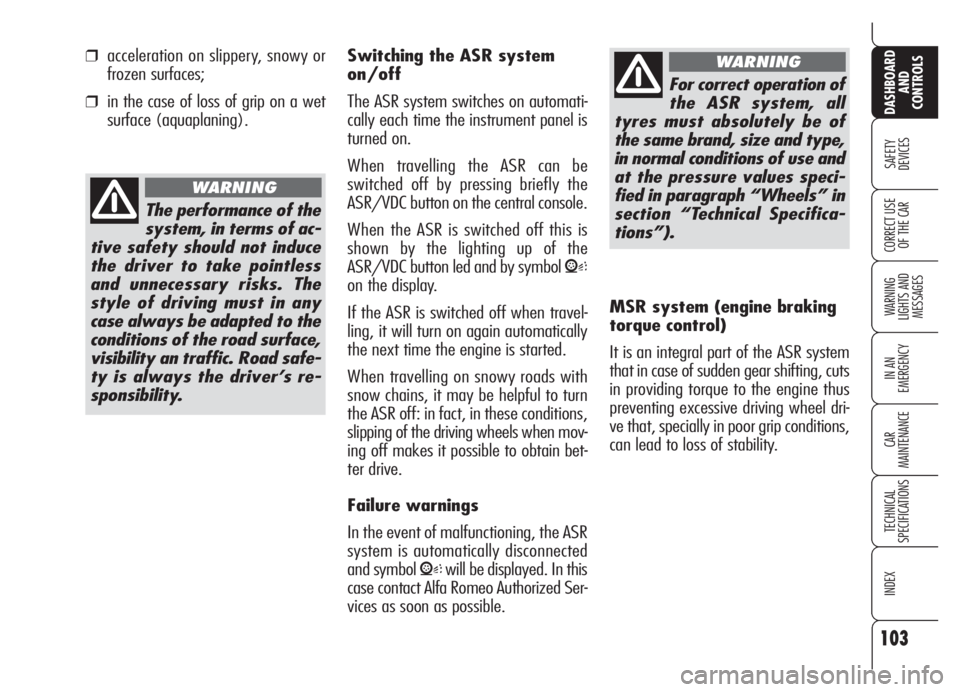
103
SAFETY
DEVICES
WARNING
LIGHTS AND
MESSAGES
IN AN
EMERGENCY
CAR
MAINTENANCE
TECHNICAL
SPECIFICATIONS
INDEX
DASHBOARD
AND
CONTROLS
CORRECT USE
OF THE CAR
❒acceleration on slippery, snowy or
frozen surfaces;
❒in the case of loss of grip on a wet
surface (aquaplaning).
The performance of the
system, in terms of ac-
tive safety should not induce
the driver to take pointless
and unnecessary risks. The
style of driving must in any
case always be adapted to the
conditions of the road surface,
visibility an traffic. Road safe-
ty is always the driver’s re-
sponsibility.
WARNING
Switching the ASR system
on/off
The ASR system switches on automati-
cally each time the instrument panel is
turned on.
When travelling the ASR can be
switched off by pressing briefly the
ASR/VDC button on the central console.
When the ASR is switched off this is
shown by the lighting up of the
ASR/VDC button led and by symbol
V
on the display.
If the ASR is switched off when travel-
ling, it will turn on again automatically
the next time the engine is started.
When travelling on snowy roads with
snow chains, it may be helpful to turn
the ASR off: in fact, in these conditions,
slipping of the driving wheels when mov-
ing off makes it possible to obtain bet-
ter drive.
Failure warnings
In the event of malfunctioning, the ASR
system is automatically disconnected
and symbol
Vwill be displayed. In this
case contact Alfa Romeo Authorized Ser-
vices as soon as possible.
For correct operation of
the ASR system, all
tyres must absolutely be of
the same brand, size and type,
in normal conditions of use and
at the pressure values speci-
fied in paragraph “Wheels” in
section “Technical Specifica-
tions”).
WARNING
MSR system (engine braking
torque control)
It is an integral part of the ASR system
that in case of sudden gear shifting, cuts
in providing torque to the engine thus
preventing excessive driving wheel dri-
ve that, specially in poor grip conditions,
can lead to loss of stability.
Page 105 of 270
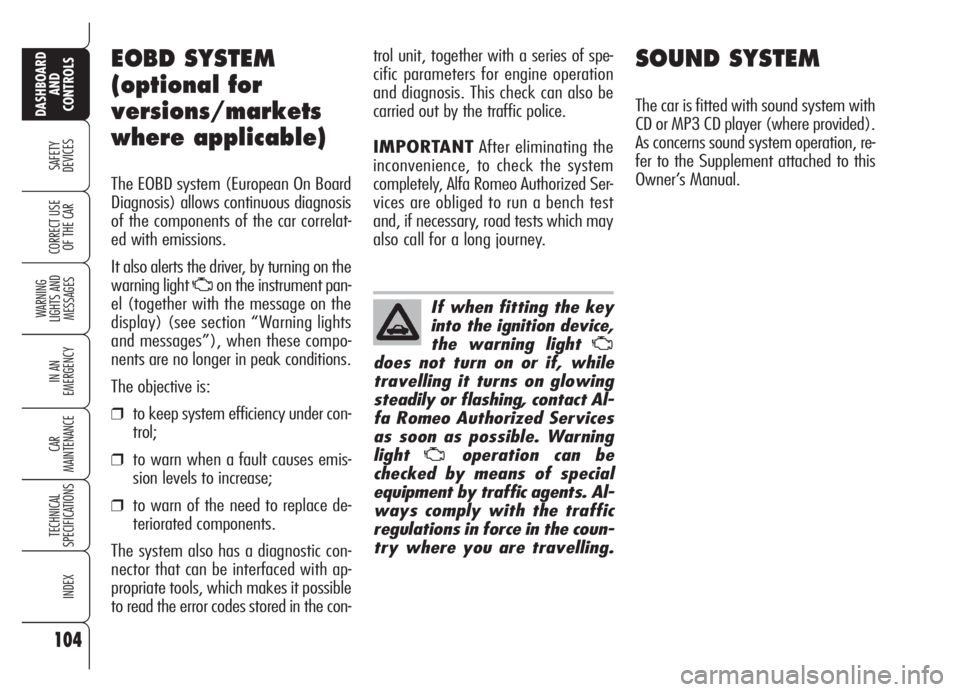
104
SAFETY
DEVICES
WARNING
LIGHTS AND
MESSAGES
IN AN
EMERGENCY
CAR
MAINTENANCE
TECHNICAL
SPECIFICATIONS
INDEX
DASHBOARD
AND
CONTROLS
CORRECT USE
OF THE CAR
SOUND SYSTEM
The car is fitted with sound system with
CD or MP3 CD player (where provided).
As concerns sound system operation, re-
fer to the Supplement attached to this
Owner’s Manual.
EOBD SYSTEM
(optional for
versions/markets
where applicable)
The EOBD system (European On Board
Diagnosis) allows continuous diagnosis
of the components of the car correlat-
ed with emissions.
It also alerts the driver, by turning on the
warning light
Uon the instrument pan-
el (together with the message on the
display) (see section “Warning lights
and messages”), when these compo-
nents are no longer in peak conditions.
The objective is:
❒to keep system efficiency under con-
trol;
❒to warn when a fault causes emis-
sion levels to increase;
❒to warn of the need to replace de-
teriorated components.
The system also has a diagnostic con-
nector that can be interfaced with ap-
propriate tools, which makes it possible
to read the error codes stored in the con-
If when fitting the key
into the ignition device,
the warning light
U
does not turn on or if, while
travelling it turns on glowing
steadily or flashing, contact Al-
fa Romeo Authorized Services
as soon as possible. Warning
light
Uoperation can be
checked by means of special
equipment by traffic agents. Al-
ways comply with the traffic
regulations in force in the coun-
try where you are travelling.
trol unit, together with a series of spe-
cific parameters for engine operation
and diagnosis. This check can also be
carried out by the traffic police.
IMPORTANTAfter eliminating the
inconvenience, to check the system
completely, Alfa Romeo Authorized Ser-
vices are obliged to run a bench test
and, if necessary, road tests which may
also call for a long journey.